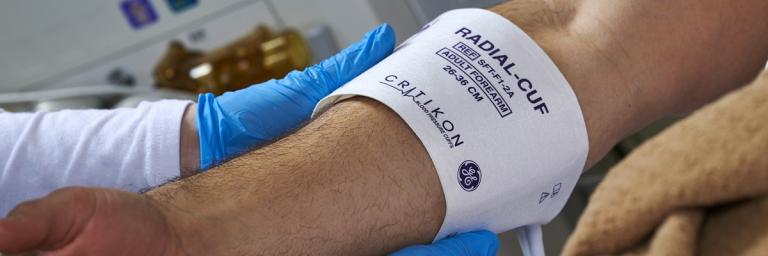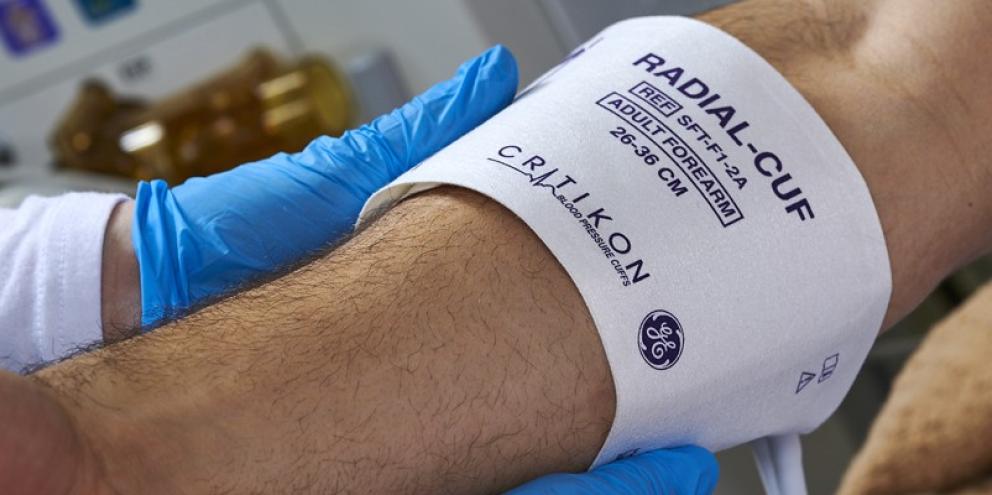
Noninvasive blood pressure (NIBP) cuffs that wrap around a patient's upper arm are a ubiquitous sight in healthcare settings. However, standard cuffs are not always effective for certain populations, such as people who are overweight, obese, or overly muscular—and that presents a problem.
Accurate blood pressure measurements are critical to uncovering potentially life-threatening illnesses such as hypertension and hypotension, both of which can increase the risk of heart attack, stroke, and chronic kidney failure.
Blood pressure guidelines1 from the American College of Cardiology and the American Heart Association (AHA) emphasize the importance of proper techniques for measuring blood pressure, including using a correctly sized cuff that encircles 80% of the arm.
If your practice doesn't have a variety of cuff sizes that meet these guidelines for your entire patient population, then diversifying your inventory is a worthwhile investment. Because one size—quite literally—does not fit all.
Right-Sizing for Specific Populations
It's likely that much of your patient population can use standard upper arm blood pressure cuffs, which are designed to fit cylindrical arms. However, obese and muscular patients may have more conical arms, and standard cuffs may be too small or otherwise fit poorly, resulting in falsely elevated blood pressure values—and even small errors in blood pressure values have the potential for long-term effects. As an example, overestimating blood pressure by just 5 millimeters of mercury (mm Hg) can lead to an incorrect diagnosis of prehypertension when true hypertension is present.2 That incorrect diagnosis can in turn lead to improper treatment, potentially introducing adverse drug effects and unnecessary costs.
While both muscular and obese patients may struggle to get accurate results from a standard cuff, each patient population carries its own unique points of concern.
Muscular Patients
Incorrectly cuffing a muscular arm can lead to significant errors in both systolic and diastolic blood pressure readings. Upper arm muscle mass index tends to overestimate systolic blood pressure and underestimate diastolic blood pressure.3
One study found that an upper arm cuff cannot exert uniform pressure on patients with muscular arms—a potential source of misleading measurements. Of note, gender was a significant predictor of blood pressure discrepancy, as men had the highest incidence of incorrect readings.4
Overweight and Obese Patients
Getting an accurate measurement using a standard adult cuff can be particularly challenging for obese women with a short humerus length.5 The elbow-facing end of the cuff often remains loose, expanding irregularly over the lower part of the arm. This can cause providers to overestimate the patient's blood pressure; in some cases, there may be a systolic blood pressure difference of 10 mm Hg.
A conical cuff generally fits the natural contour of the upper arm of obese patients better than a standard cylindrical cuff, according to the American Journal of Hypertension. About 15% of severely obese patients who were thought to be hypertensive after using a cylindrical cuff were actually found to be normotensive when their blood pressure was measured with a conical cuff.6
Upgrading NIBP Technology
Large, conically shaped upper arm cuffs may seem like a sufficient option for these patient populations. However, there is another method for measuring blood pressure for the obese and overly muscular, a forearm cuff. Unlike the upper arm, forearm circumference typically remains within narrow limits regardless of weight or muscle mass.
Additionally, patients' blood pressure still changes when moving from the aorta to the peripheral arteries. For most patients, systolic blood pressure increases, while diastolic blood pressure decreases in the peripheral arteries. Therefore, a forearm cuff can capture pressure in the artery beneath the cuff, with the benefit of minimal cuff slippage.
GE’s forearm cuff is the first NIBP forearm cuff that has been clinically validated and specifically designed for use on obese and overly muscular patients.
Among its other benefits, GE’s forearm cuffs:
- Can be paired with a single patient throughout their hospital stay, reducing the risk of infection if they're transferred from room to room.
- Contains no DEHP or rubber latex, making it safe for patients. (Long-term exposure to DEHP can cause cancer or birth defects, and rubber latex can cause mild to severe allergic reactions in patients.)
- Created from a soft, absorbent material that has rounded corners for patient comfort.
Ensuring the Accurate Results
Although the standard upper arm blood pressure cuff may be fine for many, obese and muscular patients face the potential for over- or underestimation of blood pressure measurements. Don't take the risk of misdiagnoses and poor health outcomes; diversify your cuff inventory to match your diverse patient population.
Keeping a variety of blood pressure cuffs to meet patients' needs enables accurate readings—and, in turn, exceptional treatment.
References:
[2] https://www.ncbi.nlm.nih.gov/pmc/articles/PMC2911816/
[4] https://www.nature.com/articles/hr2010146
[5] https://onlinelibrary.wiley.com/doi/epdf/10.1111/jch.13301








